To listen to RTÉ.ie's radio and podcast services, you will need to disable any ad blocking extensions or whitelist this site.

0
00:00
00:00
Episode Notes
Panel: Éanna Ní Lamhna and Niall Hatch
If you happen to be an early riser, you may have noticed that the dawn chorus is already well underway. Over the coming weeks it is only going to become stronger and more beautiful, as the nesting season progresses and the birds compete loudly with each other for territories and mates.
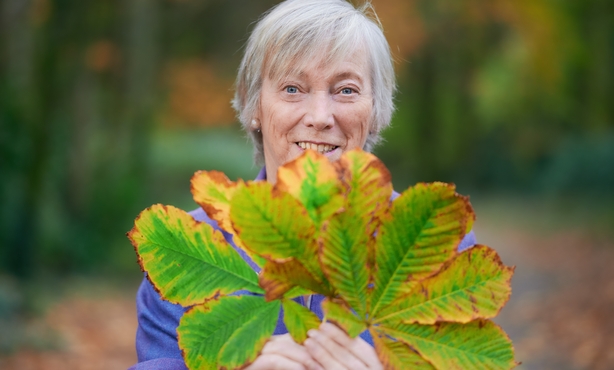
If you are a fan of birdsong, don't forget that our very popular live International Dawn Chorus broadcast will be happening again this year, in the early hours of Sunday 1st May on RTÉ Radio One. We’ll have full details for you very soon, so stay tuned to Mooney Goes Wild for more.
Creating a buzz around rare bees in Co. Mayo
Ireland is home to a total of 21 bumblebee species, and the largest and rarest of these is the impressive Great Yellow Bumblebee. Formerly widespread across the country, these bright yellow insects are now classified as 'endangered’ on the Irish Red List. The only remaining known viable population is found in Co. Mayo, on the Mullet Peninsula and the nearby Erris coastal mainland.
The steep decline of Irish Great Yellow Bumblebee population is believed largely to be as a result of the loss of rich flower meadows across the country. As traditional hay meadows gave way to intensive silage production, so feeding opportunities for these bees disappeared.
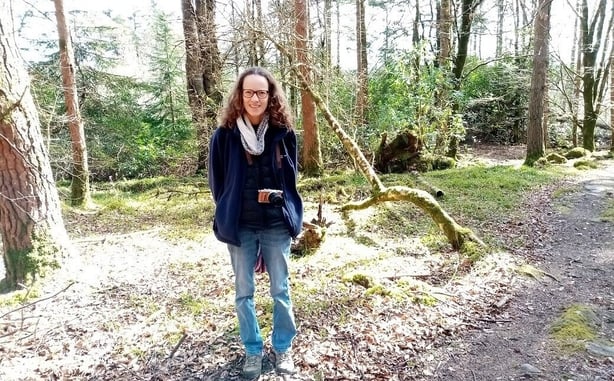
In an effort to halt the decline of this endangered species, the Great Yellow Bumblebee Conservation Group was set up to find ways to support it and to raise awareness of its plight. It was awarded funding through the European Innovation Partnership (EIP), which supports projects that allow farmers, scientists and other experts to collaborate together to develop practices that are both environmentally friendly and economically sustainable. The ultimate aim of these innovation partnerships is to road-test new ideas and practices which can then be used more widely by farmers and others.
On tonight’s programme, we are joined by Dr. Karina Dingerkus, an ecologist with the Great Yellow Bumblebee EIP conservation project, who tells us how the project partners are working with a host of different groups and other stakeholders, including local farmers. The project’s key aims are to find sustainable ways in which to enhance flora-rich farmland habitats and to increase connectivity between them. This in turn will provide vital foraging and breeding habitat for the bees, as well as great many other pollinating insects.
For more information about the Great Yellow Bumblebee EIP Project, visit https://www.belmullettidytowns.com/great-yellow-bumblebee
Starling in a sticky situation
We received a video during the week from one of our colleagues in which he captured an all-dark bird apparently trying to bring a long stick into a small hole under the roof of his house. As we hear on tonight’s programme, the bird in question is a Starling, and this is behaviour that many of these birds exhibit at this time of year. This is the start of the breeding season for this species and spaces inside attics make an ideal safe, warm and dry location in which they can build their nests. That is what the stick was for, of course: if you ever happen to see a bird carrying a stick, it is almost certainly planning to use it as nesting material.
If you happen to know of any unusual nesting sites where birds have recently taken up residence, please let us know by emailing mooney@rte.ie
Please take great care not to disturb the birds in any way, however. We would especially ask you please to refrain from taking and photos or videos of them at or near their nests: under the Wildlife Acts, this is illegal without a licence from the National Parks and Wildlife Service.
For more information about Starlings, visit https://birdwatchireland.ie/birds/starling/
Daredevil Blackbird in Donnybrook
Starlings aren’t the only birds with nesting on their minds at this time of year. All over Ireland, literally millions of birds are currently courting, mating, nest-building, laying, incubating and/or feeding ravenous nestlings. The relentless pressures of tending to demanding chicks means that sometimes birds can be forced to take risks that they would not otherwise consider.
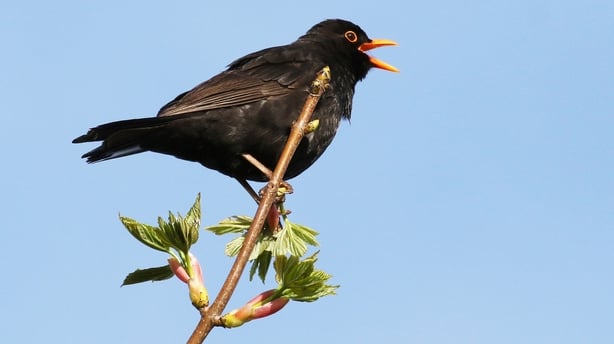
Derek witnessed just such an incident last week when, at Donnybrook Bridge in Dublin, he saw a male Blackbird with a beak full of worms frantically flying low over the road from the River Dodder to the Sacred Heart Church. It was very lucky not to have been hit by a car, and at this time of year literally thousands of nesting birds are not so fortunate. In a rush to bring as much food to their nests as possible, many of them are killed by traffic. This in turn means that the survival chances of their offspring are greatly reduced: with one parent fewer to feed them and to watch for danger, sadly the odds are stacked against them.
As we learn tonight, if you see a bird transporting food in its bill, it’s a sure sign that it is nesting. The food will be intended either for hungry chicks or, with some species at least (including the Blackbird), possibly for the bird’s mate, sitting on the nest incubating the eggs.
For more information about Blackbirds, visit https://birdwatchireland.ie/birds/blackbird/
The mystery of the missing Greenfinches
We receive a huge volume of emails each week from listeners who want to avail of our panellists’ natural history expertise. One such request came to us on 6th April from Olive Kelly in Kilbeggan, Co. Westmeath. Olive asked:
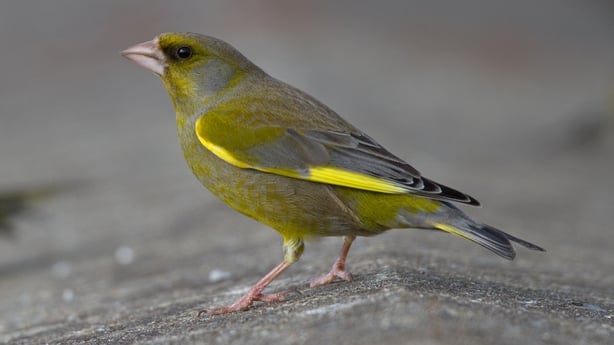
Would you or your contributors know how Greenfinches are doing? I have done BirdWatch Ireland’s Irish Garden Bird Survey for the past few years and Greenfinches always came to the garden. Except this year, there were none! Yesterday, I spotted the first one this year.
As Niall tells us, unfortunately Ireland has experienced a massive decrease in Greenfinch numbers in recent years, and the Irish Garden Bird Survey results have shown that they are now absent from a great many gardens where they used to occur until quite recently. The culprit is a nasty disease called trichomoniasis, which has had a devastating effect on them and usually proves fatal.
We would stress that this disease poses no risks whatsoever to humans, nor indeed to any other mammals, and most bird species also appear to be immune to it. For finches, and especially for Greenfinches, it is very serious, however, and there is no practical cure.
For more information about trichomoniasis, visit https://birdwatchireland.ie/our-work/surveys-research/research-surveys/irish-garden-bird-survey/trichomoniasis-sick-finches/
For more information on Greenfinches, visit https://birdwatchireland.ie/birds/greenfinch/
A garden polling station, of sorts
We also received an email from listener Liz Rogan, who had the following query for us, as well as some handy bird-feeding tips:
I have two pairs of Redpolls feeding at my bird feeder every day. What is their natural habitat?
I also have hundreds of finches, particularly Goldfinches. Each morning, I fill the feeders with Nyger seeds. A good friend made me a feeding station, which is great. Crows, Magpies, etc. can't invade when smaller birds are feeding. I feed bigger birds in front garden, while smaller ones are out the back.
Redpolls are charming little members of the finch family that nest mainly in upland coniferous plantations during the summer, then spread out across the country in the autumn and winter, feeding on tree seeds and at garden feeders. During the winter months they are particularly fond of stands of ash and birch trees, which provide plenty of the tiny seeds that they like so much.
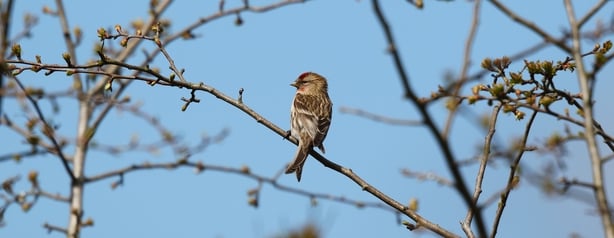
Redpolls are named for their distinctive red foreheads, which contrast sharply with their otherwise largely brown, streaky plumage: ‘poll’ is an old word for ‘forehead’, hence the terms ‘opinion poll’ or ‘election poll’ signifying a metaphorical ‘count of foreheads’, or a headcount.
For more information about Redpolls, visit https://birdwatchireland.ie/birds/lesser-redpoll/
You can also find lots of additional tips on caring for garden birds at https://birdwatchireland.ie/irelands-birds-birdwatch-ireland/garden-birds/
A close encounter with a Long-eared Owl
Another listener, Christopher McCluskey, was also in touch via email, and this time he sent us a photo with his query:
Hi Niall, I heard you talking about owls on Mooney goes Wild a few months back. This fella arrived to our house last night. I'm told it might be a Long-eared Owl. I've never seen one so close before. We live in Dublin but beside a park and stables, so I suppose it is a good habitat with plenty of food.
Christopher is absolutely correct: the bird he photographed is indeed a Long-eared Owl. It’s difficult to get such good views or to take such clear photos of them, largely because they are so secretive and tend only to be seen after dark. The species is more common and widespread in Ireland than many people expect, however, and it is by far the most numerous of our three regularly occurring owl species.
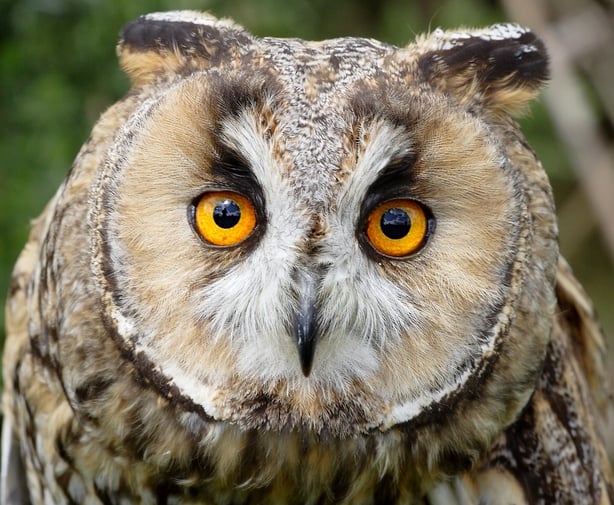
The easiest way to confirm the presence of Long-eared Owls is in June and July, when their young make far-carrying calls throughout the night. These are begging calls: the chicks, having just recently left their nests, are hungry and want their parents to bring them food. This particular cry is very distinctive: it is oddly reminiscent of the sound of a gate swinging on rusty hinges.
For more information about Long-eared Owls, visit https://birdwatchireland.ie/birds/long-eared-owl/
University College Cork: leading the charge on climate change and biodiversity loss
Last week, the UN issued a stark warning that action to tackle climate change is urgently needed. Here’s Jim Skea, the Co-chair of the Intergovernmental Panel on Climate Change (IPCC):
The twin issues of climate change and biodiversity loss are arguably the greatest that our species has ever faced. While a great deal of work is currently going into addressing them, reversing them and lessening their impacts, it could certainly be argued that University College Cork is the leading Irish university when it comes to research into these two grave threats.
There are over 550 researchers engaged in environmental research at UCC, as well as two of
Ireland's leading research institutes: the Environmental Research Institute and the Science
Foundation Ireland Research Centre for Energy, Climate and Marine. They are the forefront on providing insight into Ireland’s energy challenges and informing national policy.
On tonight’s programme, we speak to UCC President Prof. John O’Halloran, who talks us through some of the ground-breaking sustainability research currently underway on campus.
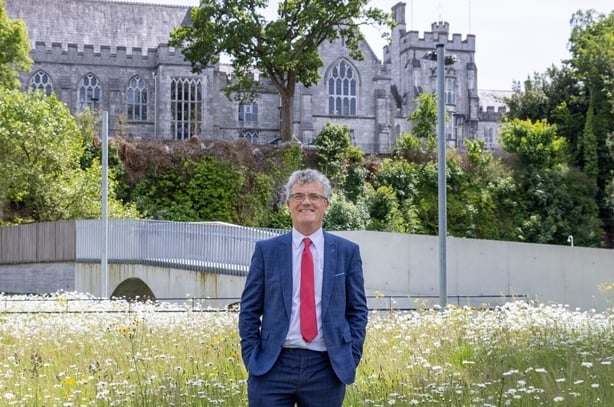
His colleague Prof. Marcel Jansen also tells us about the university’s highly innovative EU-funded Brainwaves Project, which has found a way to convert contaminated wastewater into animal fodder, at the same time cleaning the water, capturing carbon and reducing the agricultural carbon footprint. And it all comes down to duckweed!
John also brings us news of an exciting new art exhibition centred around natural history. Entitled Parklife: Biodiversity in Contemporary Irish Art, it will run at the Glucksman gallery on the UCC campus until 10th July. Entry is free, though a donation of €5 is suggested.

For more information about sustainability and climate action research at University College Cork, visit https://www.ucc.ie/en/research/sustainabilityclimateaction/
For more information about the Parklife: Biodiversity in Contemporary Irish Art exhibition, visit https://www.glucksman.org/exhibitions/parklife
